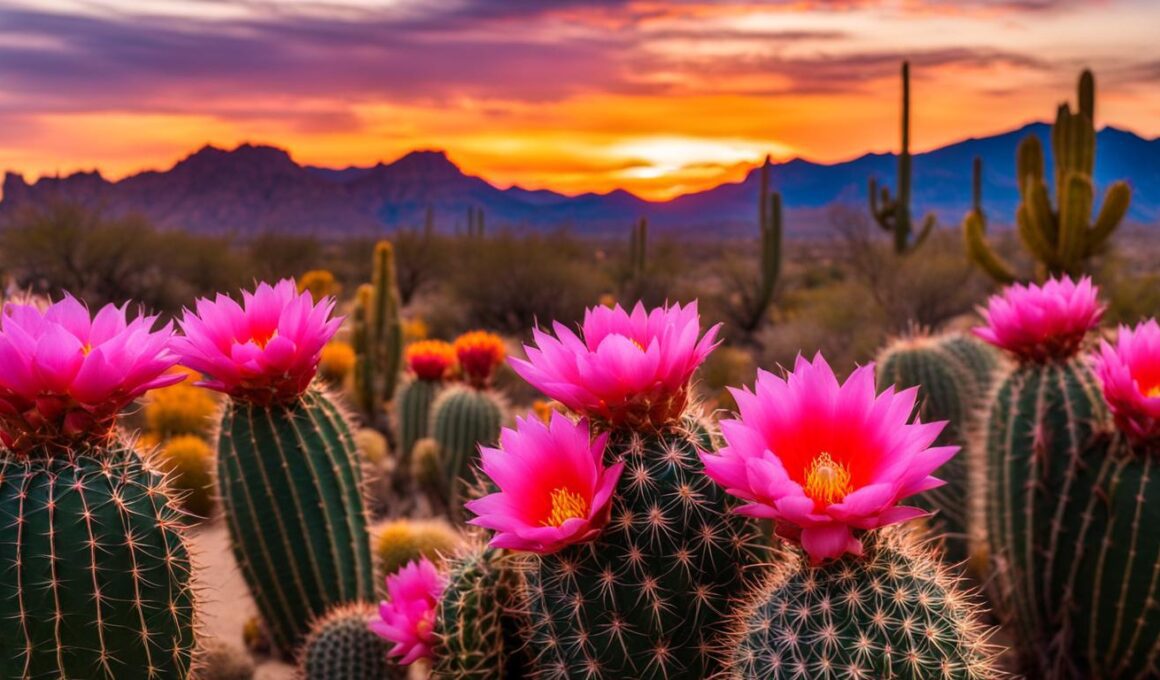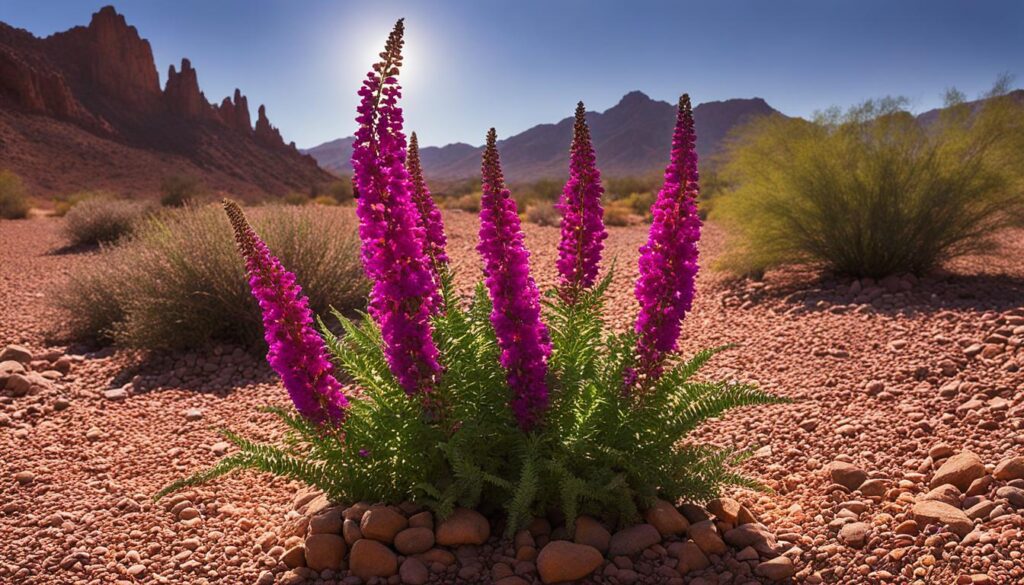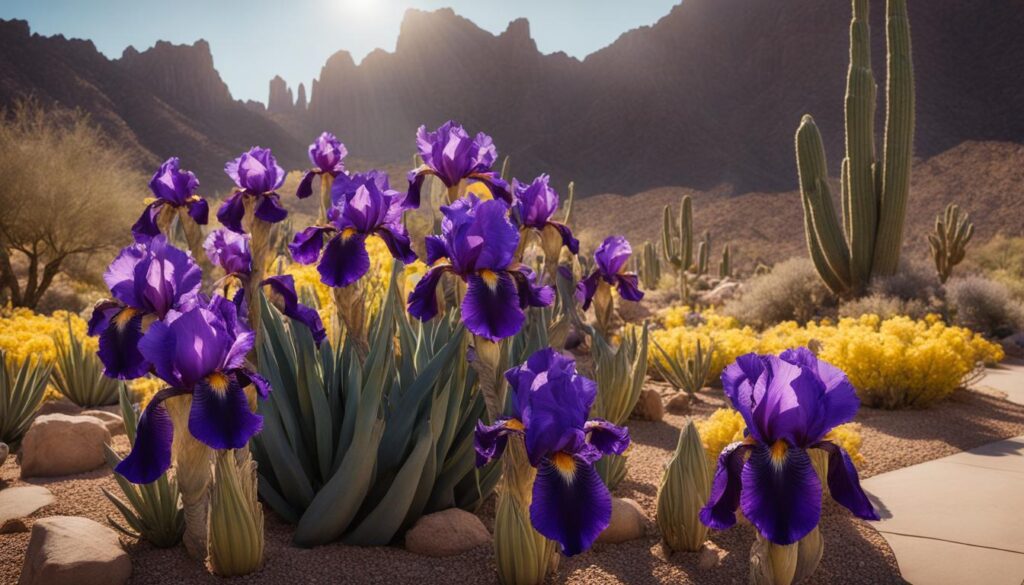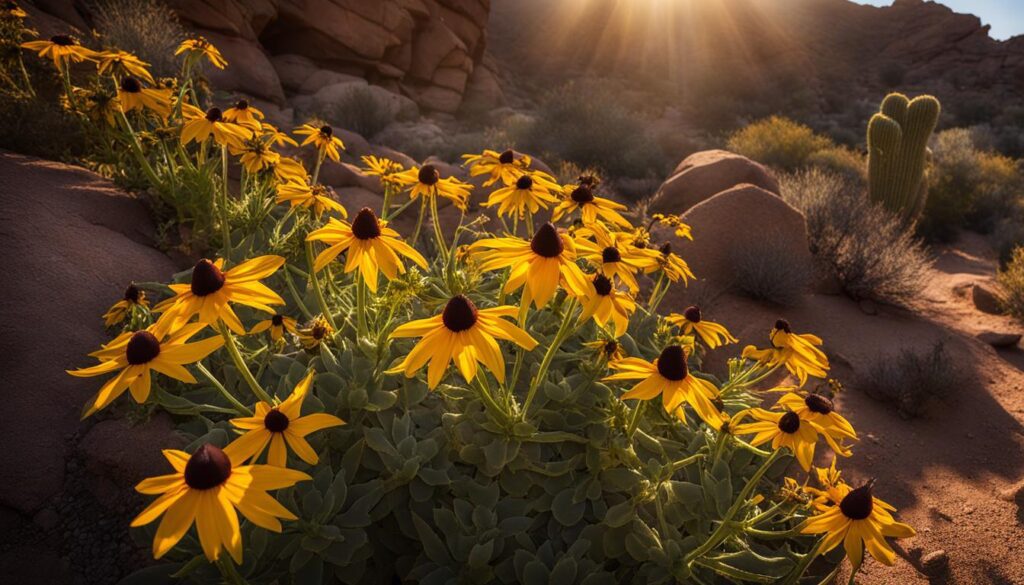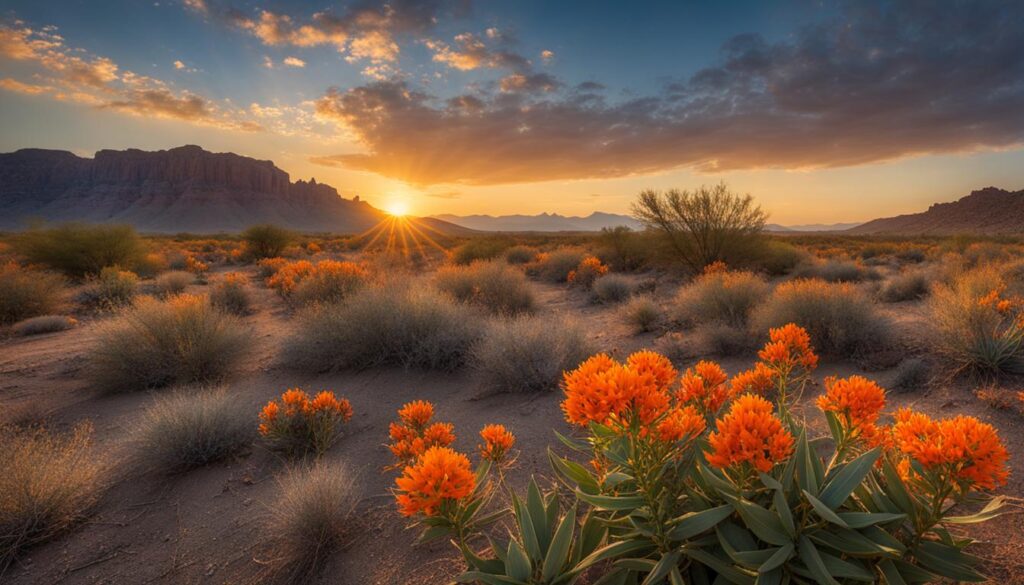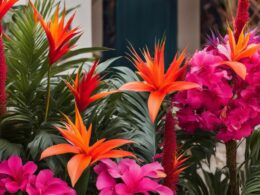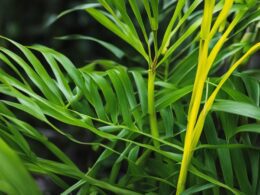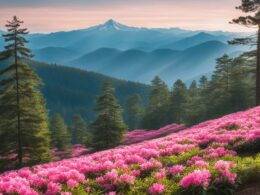As you delve into the world of Arizona gardening, you’ll discover that creating a lush desert oasis brimming with vibrant blooms is not only achievable but can also be incredibly rewarding. With a keen eye for selecting resilient desert flowers, your garden can transform into a tapestry of color and life, even under the sizzling sun.
Planning Your Arizona Flower Garden
Immersing yourself in desert landscaping can be quite the adventure, especially when you’re aiming to cultivate an oasis that not only withstands the heat-tolerant demands of Arizona but flourishes with sun-loving flowers. To transform your arid plot into a vibrant floral exhibition, a thoughtful approach to garden planning is key.
Understanding the Arizona Climate
You’re living in a region where the sun reigns supreme, and your plants must thrive under its intense gaze. Areas within the plant hardiness zones 5 to 12 host a distinctive climate defined by extreme heat, limited rainfall, and stark sunlight. It’s essential to choose plants accustomed to these conditions to ensure the success of your Arizona garden.
Selecting the Right Plant Type: Annuals vs. Perennials
Deciding between annuals and perennials is crucial as they greatly differ in lifespans and blooming patterns. While annuals like Amaranths, Angelonia, and Gaillardia inject your garden with a summer-long display of vigor, perennials such as the Baja Fairy Duster and Bearded Irises return yearly, offering enduring elegance and a structured look to your desert escape.
Considering Garden Space and Sun Exposure
The available space in your garden and the level of sun exposure it receives are pivotal in selecting the right plants. Ideally, your choice should not only align with the Arizona climate but also fit spatially while meeting their sunlight preferences. To cultivate a thriving garden, consider plants that effortlessly embrace the sunny expanses of your outdoor space.
Heat Resistant Beauties: Amaranth and Angelonia
If you’re a gardening enthusiast in the sun-drenched landscapes of Arizona, you’re in for a treat with the amaranth plant and angelonia flowers. These botanical wonders exemplify the essence of heat-resistant gardening, turning your gardens into a standout canvas of year-round beauty, even under the relentless Arizona sun.
The amaranth plant, a real showstopper, soars upwards of 4 to 6 feet, boasting a spectrum of vibrant colors that demand attention. Packed with resilience, amaranth stands tall against the adversary of arid climates, welcoming full to partial sunlight while braving high heat, drought conditions, and even neglect without a hint of distress. As a favorite among full sun plants, it’s not only a visual delight but a beacon for bees, butterflies, and hummingbirds, enriching your garden’s biodiversity.
On the other hand, angelonia flowers grace the garden with an air of elegance through stalks bursting with purple, pink, and white blossoms. Angelonia’s stamina in facing intense heat is noteworthy, requiring no respite from the summer blaze unless frost makes an unexpected appearance. Its continuous summer blooming not only embellishes your garden palette but also becomes a magnet for pollinators that enliven your outdoor sanctuary.
- For a seamless integration into your garden, start amaranth seeds indoors before transitioning them outside between March and mid-July. Relish their blooms from April until the fall’s embrace in October.
- With angelonia, grace your garden by transplanting in the spring to capture its beauty throughout summer. A little occasional fertilization goes a long way in uplifting its vigor.
Undeniably, incorporating amaranth and angelonia into your gardening repertoire ensures that your Arizona haven will not only sustain but thrive amidst sizzling temperatures, offering a spectacle of colors and life that persists beyond the challenges of extreme heat.
The Vibrant Baja Fairy Duster
Embark on a journey to transform your Arizona garden with the captivating Baja fairy duster, a desert shrub that embodies the resilience and beauty of the region. This perennial shrub is not only a spectacle of color but a beacon of life, drawing in diverse wildlife while flourishing amidst the sun-soaked landscapes. Its unique, bristle-like blooms—which appear in an array of red, rose, or plum shades—create a picturesque setting that instantly elevates your outdoor space.
As a desert shrub, the Baja fairy duster’s impressive form, reaching 5-6 feet tall, makes it an ideal addition to Mediterranean or desert-themed gardens. Its hassle-free nature, being both disease and pest-resistant, allows it to thrive in full sun with minimal maintenance requirements, ensuring your garden remains an enchanting retreat throughout the year.
Plant Features and Landscape Uses
With its evergreen or semi-evergreen foliage, the Baja fairy duster is a versatile choice for any landscaper seeking year-round interest. Its robust nature requires little to no pruning, empowering you to create breathtaking landscapes that stand the test of time with minimal effort. Place this dazzling shrub where it can enjoy unfettered access to the Arizona sun, and watch as it transforms your garden into a haven of vibrant greenery and warm hues.
Attracting Hummingbirds with Colorful Blooms
As a hummingbird-friendly plant, the Baja fairy duster is unparalleled. Its summer and fall blooms act as lush magnets for these charming birds, infusing your yard with life and movement. Crafting a sanctuary for hummingbirds not only contributes to the ecological well-being of your local environment but also brings a sense of wonder and delight as you observe these feathered friends in their natural dance.
Your garden awaits its transformation with the enchanting blooms of the Baja fairy duster. Plant one, and you plant a cornerstone of a thriving, hummingbird-friendly ecosystem in your very own backyard.
Bearded Irises: Elegance Meets Resilience
As you curate your Arizona garden to thrive in the relentless desert sun, consider the addition of bearded iris varieties. These vibrant perennial blooms offer a breathtaking display, introducing a variety of hues from the boldest of reds to the purest whites, and enchanting mixed shades. The bearded iris is famed not just for its striking appearance but also for its remarkable resilience in dry climates.
With their elegant, often ruffled petals, bearded irises serve as a centerpiece in any garden, providing height and dimension among lower-growing drought-tolerant flowers. They’re perfectly suited for the diverse soils and conditions of Arizona, asking only for sunlight to showcase their splendor and a bit of shade when the afternoon rays become too harsh.
Yet, their toughness transcends their preference for sunlight. Bearded irises flourish under conditions that would see many other plants wilt. Their ability to withstand prolonged dry spells makes them essential candidates for the water-conscious gardener. Here’s how you can ensure your bearded irises are set for success:
- Choose a sunny location with well-drained soil, as bearded irises despise wet feet.
- Plant them with the upper parts of their rhizomes exposed to help avoid rot and to bask in full sun.
- Water sparingly once established, as they are remarkably drought-tolerant.
- Provide some afternoon shade to protect their vivid blossoms from the most intense heat in the peak of summer.
Throughout early spring to early summer, the bearded iris makes its presence known, transforming your garden with a parade of color and form. This adherence to survival in the most demanding conditions is proof positive that beauty in the desert isn’t just an oasis mirage—especially when you have bearded iris varieties anchoring your landscape design.
Black-eyed Susans: A Dazzle of Yellow
Imagine your garden bursting with the vibrant, sunlit faces of Black-eyed Susans. These dynamic perennial flowers are not just a feast for the eyes; their bright yellow petals and distinctive dark centers can enliven your landscape and are ideal for full sun gardening in the Arizona climate. Replete with hardiness, Black-eyed Susans cherish full sun yet enjoy a reprieve with some afternoon shade, striking the perfect balance between sunlight and respite to embellish your garden from June to October.
As practical as they are pretty, these perennials are a dream for gardeners who value both aesthetic appeal and ease of care. Thanks to their remarkable ability to reseed, the flowers ensure a continuous display of color throughout the summer.
And yet, the beauty of the Black-eyed Susan extends beyond its sunny disposition. Each flower is a nectar-rich hub, attracting a flurry of activity in your garden as butterflies and hummingbirds flock to partake in the bounty these blooms provide. Creating a habitat for such beneficial pollinators not only enhances the vibrancy of your space but also contributes significantly to the biodiversity of your local ecosystem.
- To encourage a robust bloom, plant your Black-eyed Susans between October and March by seed.
- Maintain their vivacious display by deadheading spent flowers throughout the blooming season.
- If reseeding is desired, leave the heads in place at the season’s end to ensure the next generation of sun-loving blossoms.
- While caring for these garden jewels, remember to avoid watering overhead as this may promote mildew growth on the leaves and blooms.
- Embrace their resilient nature in your landscape design, as they are well-suited to thrive in both garden beds and pots alike, tolerating drought and poor soil conditions with grace.
With Black-eyed Susans by your side, your full sun garden is set to become a glowing beacon of color and life in the heart of Arizona – a true spectacle of nature’s resilience and splendor.
Butterfly Weed: Low-Maintenance Splendor
In the quest to cultivate a desert garden full of life and color, the butterfly weed plant emerges as a hero among hardy desert plants. Known for being one of the most resilient native Arizona flowers, it thrives in conditions where many others might falter. But what exactly does it take to nurture these radiant blooms to their full potential? A closer look at their water and soil needs reveals just how adaptable they truly are.
Water and Soil Requirements for Optimal Growth
One might assume that with such tenacious life, the butterfly weed would require frequent watering and fertile soil. On the contrary, these sun-loving perennials excel in even the most arid conditions. They’re content with minimal hydration and can prosper in lean, unforgiving soils where others would not stand a chance. Whether it be dry, rocky, or even salt-laden earth, butterfly weed plants persevere, making them a cornerstone in the realm of water-wise gardening.
Creating a Butterfly Haven in Your Backyard
Your Arizona garden can become a sanctuary for butterflies with the addition of these magnetic perennials. Not only do the clustered, vibrant orange blossoms of the butterfly weed beckon a variety of pollinators but they also contribute to the ecosystem’s diversity. At 1 to 2 feet tall, they weave seamlessly among other plants, elevating garden beds and borders with ease.
A low-maintenance haven is yours for the making. By investing in butterfly weed plants for your landscape, you’re not just enriching the soil and saving water – you’re also inviting nature’s small wonders into your quiet slice of the desert.
Coreopsis: The Sunny Staple
When embarking on coreopsis planting in your Arizona landscape, you’re choosing a brilliant ambassador of water-wise gardening. The attractive fullness of coreopsis blooms adds a spectacular pop of color synonymous with sunny, dry environments. As you ponder the best perennials for your garden, consider how coreopsis becomes not just a visual highlight but an asset to your eco-friendly oasis.
Drought Tolerance and Pest Resistance
Coreopsis’s innate ability to thrive with minimal water makes it an ideal candidate for gardens focused on conservation and sustainability. Its drought tolerance is remarkable, allowing it to stand up to the unyielding Arizona sun with a resilience that’s as inspiring as it is beautiful. Add to that an intrinsic resistance to many pests, and you’ve got a perennial powerhouse that can withstand and flourish within the rigors of a desert climate.
Flower Varieties and Their Pollinators
The varieties of coreopsis are a testament to this plant’s versatility, with each blossoming into a brilliant display that beckons an array of perennial pollinator attractions. From the vibrant yellows to the deep reds with brown centers, your coreopsis garden will not only dazzle with its spectrum of colors but will also serve as a haven for bees, butterflies, and other beneficial pollinators, enhancing the ecological tapestry of your outdoor space.
- Your coreopsis will stand boldly at roughly two feet in height and width, furnishing your landscape with a substantial, enduring presence.
- Greet the summer warmth knowing your blooms will persevere through the fall, showcasing their vivacious hues long after other flowers might dwindle.
As a gardener, adorning your arid retreat with coreopsis means cultivating a patch of land that radiates life and beauty, supporting a thriving network of pollinators critical to our ecosystem. Embrace this water-conserving champion and watch as your garden becomes a beaming example of responsible, vibrant desert gardening.
Daylilies: A Riot of Color
Embrace the joy of cultivating daylilies in your Arizona garden for a display that paints your landscape with a riot of colors. These hardy perennials are not only renowned for their dazzling color variety but also for their resilience in withstanding the intense heat and drought conditions of the desert. Their easy-care nature makes them an ideal candidate, whether you’re a seasoned gardener or just starting to dabble in the earthy art of flower propagation.
Mixing Colors to Enhance Your Garden’s Palette
Daylilies are the quintessential choice for crafting a garden color scheme that’s both dynamic and visually stunning. Each plant bursts forth with blooms in shades varying from the most subtle pastels to the most vibrant oranges and reds, inviting you to mix and match to your heart’s content. As you plan your garden layout, imagine the endless possibilities that these multicolored gems can offer, providing an ever-evolving canvas as they come into bloom alongside your other desert flora.
Propagation through Division: Keeping Daylilies Thriving
Amplify your garden’s beauty and vitality by mastering the art of flower propagation through division—a simple yet effective gardening practice that ensures your daylilies continue to flourish year after year. About every two to three years, divide the clumps in early spring or after the blooms have faded. This procedure invigorates the plants and gives you new starts to expand your floral showcase or share with fellow gardening enthusiasts, promising new waves of blooms each season.
- Look for natural division points in the clump where plants have developed individual crowns.
- With a sharp spade or knife, separate the crowns, making sure each division has a portion of the root system.
- Replant the divisions at the same depth they were growing before and water deeply to foster root development.
- Enjoy watching your garden grow as these freshly cultivated siblings take root and prepare for their debut in the next cycle of blooming.
Your investment in cultivating daylilies promises a spectacularly colorful and vivacious garden that not only adds curb appeal but also brings you closer to the rhythms of nature. Embark on this journey and witness a glorious transformation in your corner of the world.
Dianthus: Dense Blooms in Desert Climes
As you delve into the world of desert climate gardening, you’ll find that the bold and bright dianthus flowers stand as a testament to beauty and resilience. These floricultural marvels are uniquely adept for the arid conditions of Arizona, flaunting their richly pigmented petals in hues of pink, red, and white. They epitomize what it means to have drought-resistant blooms that not only withstand, but also thrive, in the face of limited water resources.
Dianthus is the perfect addition to your desert garden blueprint, with its dense blooms creating a visual feast from spring through fall. Whether nestled within earthy borders or perched in pots, this plant comfortably reaches 6 to 12 inches tall, flourishing in both full sun and partial shade. The minimal water requisite of dianthus harmonizes with the conservation goals of water-wise landscaping, enhancing its value as a stellar pick for your garden.
Moreover, the allure of dianthus extends beyond its vibrant blooms to its role as an eco-conscious choice; it’s a favored gathering spot for pollinators such as bees and butterflies. By incorporating these flowers into your landscape, you not only embrace a palette of prolific color but also nurture a portion of an ecosystem teeming with life.
Are the Best Flowers for Planting in Alaska Also Suitable for Planting in Arizona’s Desert Climate?
When considering the best flowers to plant, it’s important to consider the climate. While hardy perennials like peonies and Siberian iris thrive in Alaska’s cooler climate, they may struggle in Arizona’s desert climate. Instead, desert-friendly options like sage, lavender, and yarrow are the best flowers to plant in Arizona.





